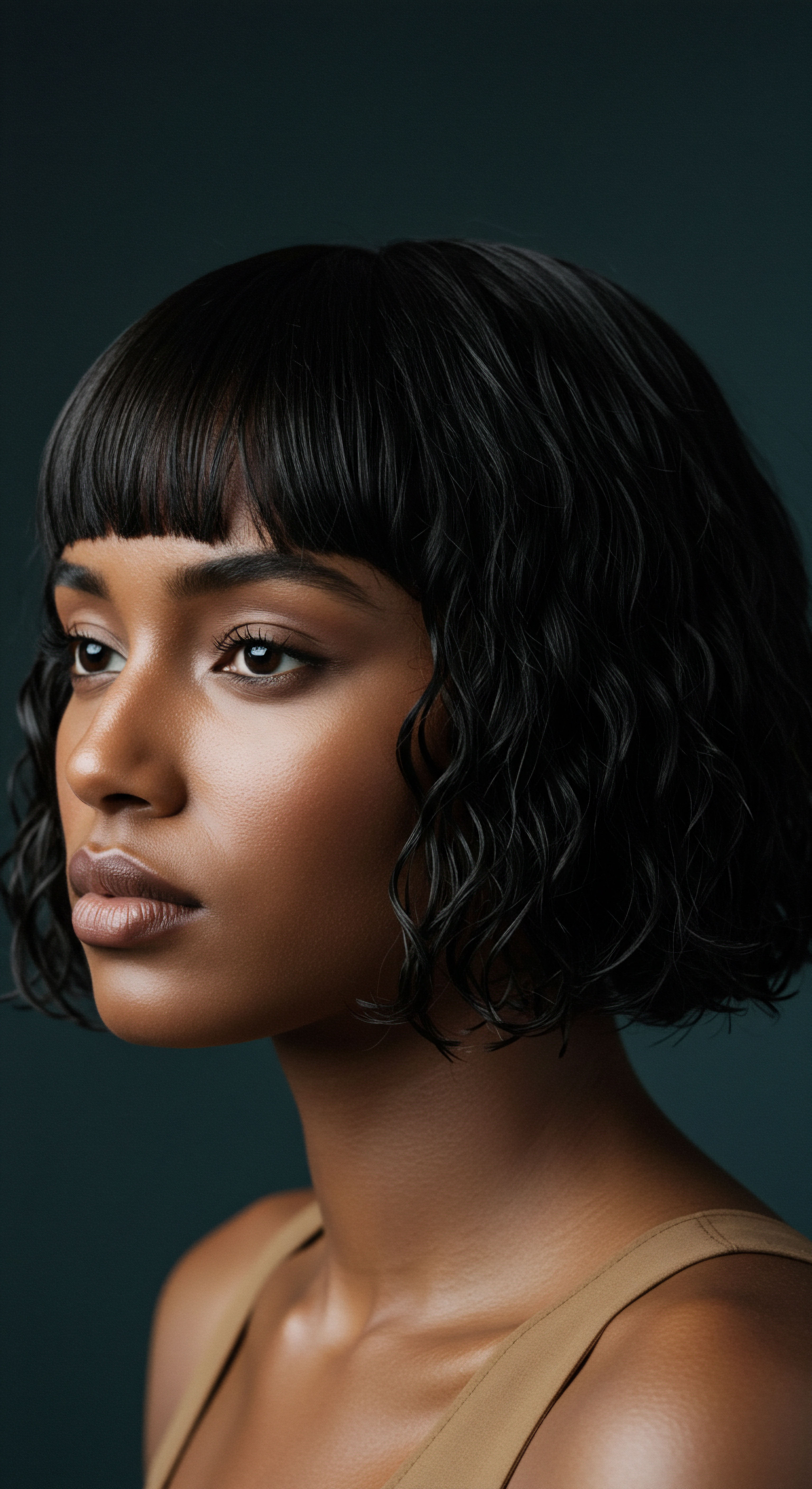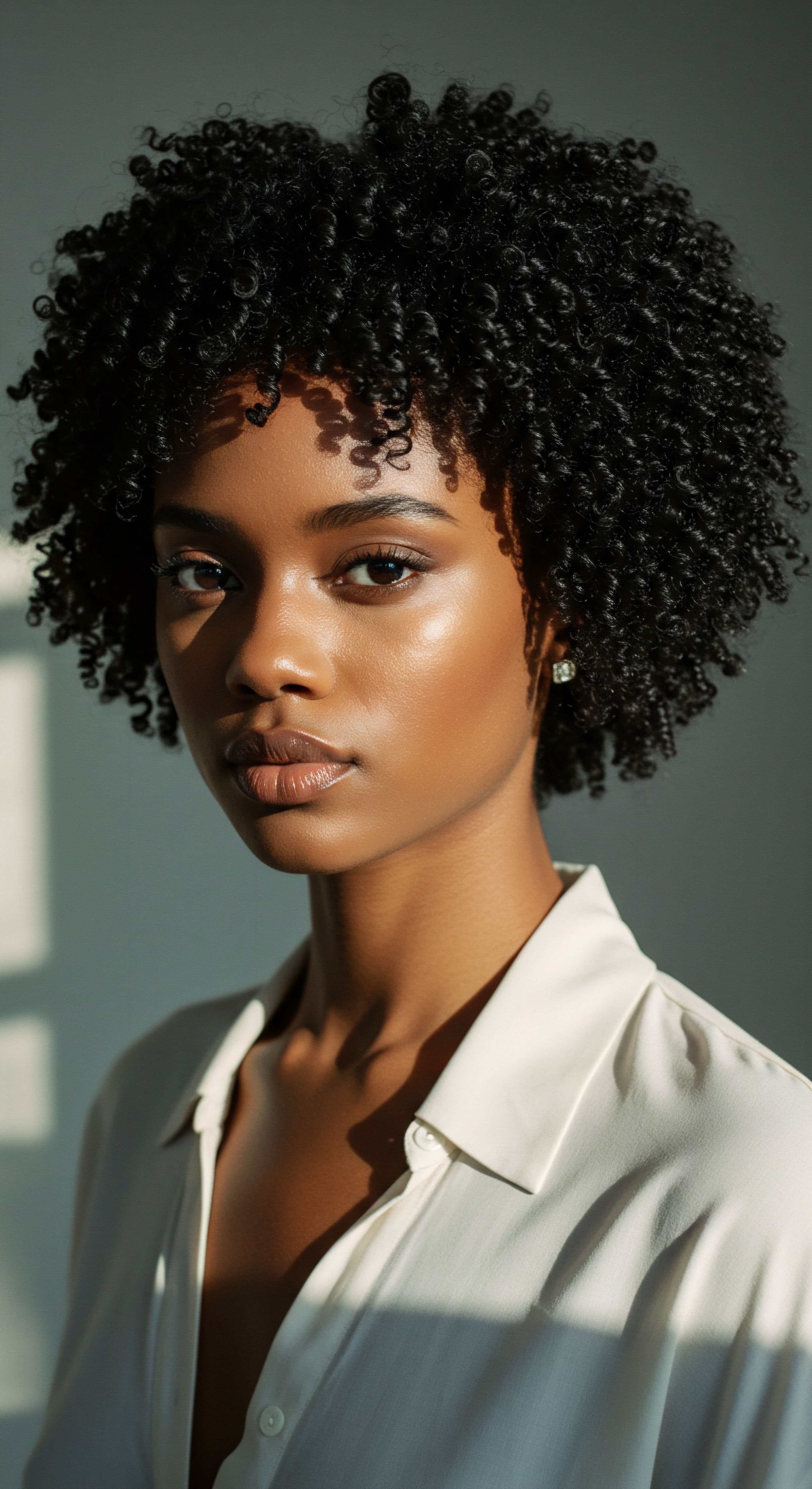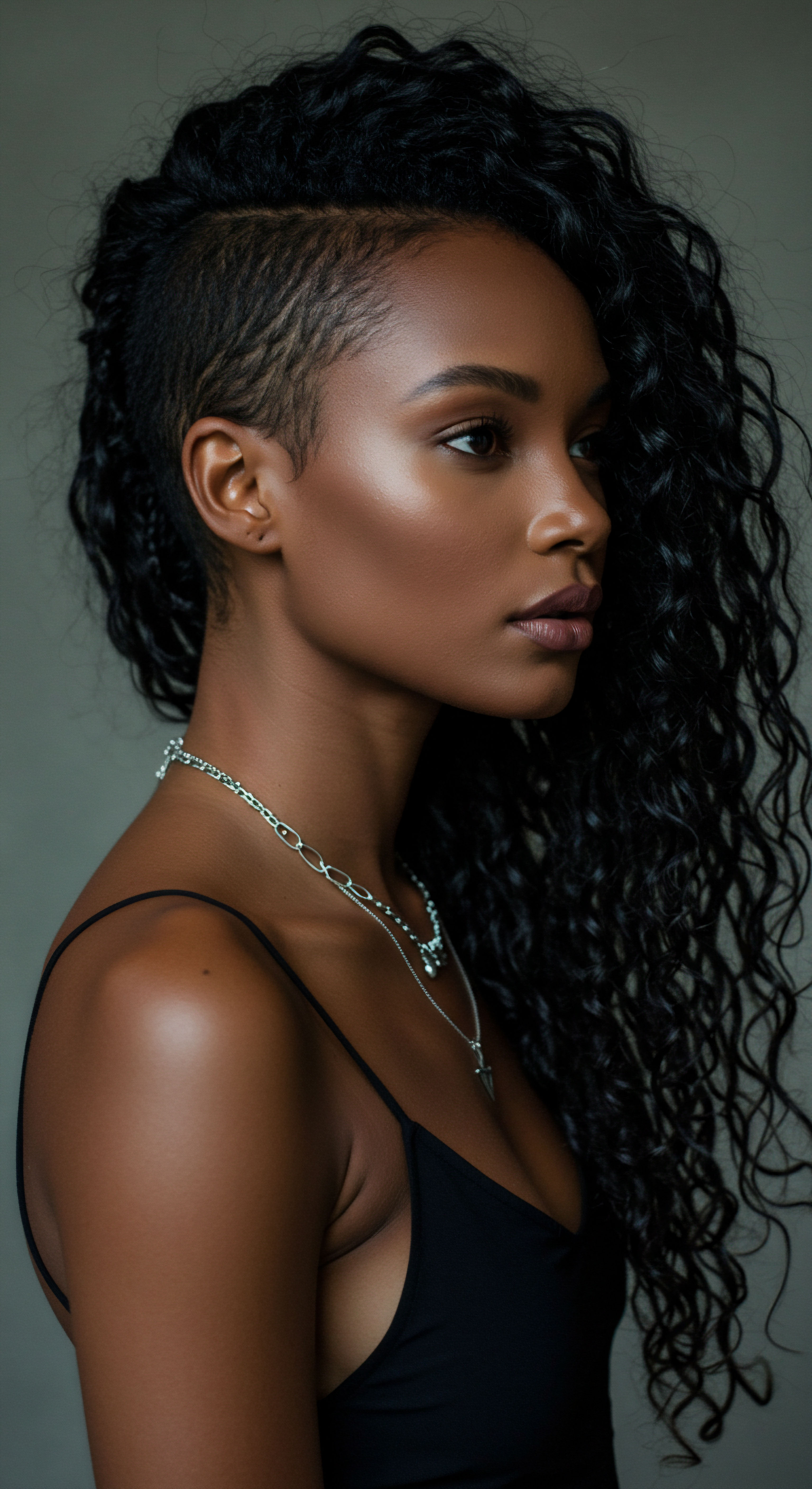
Roots
Have you ever held a single strand of your hair up to the light, perhaps after a gentle wash, and noticed how it seems to hold a quiet story of its own? This tiny filament, so often overlooked in its individual grace, carries within it a profound truth about how it interacts with the very essence of life ❉ water. This silent conversation between your curls and the world around them begins at a place often spoken of, yet perhaps not fully felt ❉ Hair Porosity. It speaks to the openness of your hair’s outermost layer, the cuticle, and how readily it welcomes or guards moisture.

The Hair’s Outer Shield
Consider the hair cuticle as a series of overlapping scales, much like the shingles on a roof. These delicate, translucent layers form the hair’s primary defense, dictating how easily water and other substances pass into or out of the inner core, the cortex. The arrangement and integrity of these scales determine what we call porosity. When these scales lie flat and tight, they form a formidable barrier, characterizing what is known as low porosity.
Water tends to bead on the surface, taking its time to penetrate. Conversely, if these scales are lifted or damaged, they offer many avenues for water to enter, yet also to depart just as quickly. This condition describes high porosity, where moisture rushes in, but struggles to stay. A balance, where the scales are neither too closed nor too open, represents medium porosity, often associated with a natural receptiveness to moisture.
Hair porosity describes the cuticle’s openness, guiding how easily moisture enters and leaves each strand.

Why Does Porosity Hold Such Sway?
The relationship between your hair’s porosity and its moisture retention is a delicate dance, a constant interplay of reception and release. For those with textured hair, this dance is particularly nuanced, as the very structure of a curl—its twists and turns—can influence how moisture travels along the strand. A tightly coiled curl, for instance, presents more surface area and more bends, potentially making it harder for natural oils from the scalp to descend the entire length, leaving the ends more susceptible to dryness. When the cuticle is open, as in high porosity, moisture can flood the strand, giving an initial feeling of hydration.
However, without a means to seal this moisture within, the hair can dry rapidly, leading to a constant cycle of thirst. For low porosity hair, the challenge lies in inviting moisture in. Products often sit on the surface, leaving a residue without truly quenching the hair’s inner thirst.
| Porosity Type Low Porosity |
| Cuticle State Tightly Closed |
| Water Absorption Slow to absorb |
| Moisture Retention Good once inside |
| Porosity Type Medium Porosity |
| Cuticle State Slightly Raised |
| Water Absorption Absorbs readily |
| Moisture Retention Well-balanced |
| Porosity Type High Porosity |
| Cuticle State Open or Damaged |
| Water Absorption Absorbs quickly |
| Moisture Retention Loses quickly |
| Porosity Type Understanding these traits guides product selection and care methods. |

Unveiling Your Hair’s Porosity
Determining your hair’s porosity is a quiet act of observation. While the float test (placing a clean strand of hair in a glass of water) is a popular home method, it provides a general indication. A more precise understanding often comes from observing how your hair behaves with water and products. Does it take a long time to get thoroughly wet in the shower, or does water seem to glide off?
This might suggest Low Porosity. Does your hair dry very quickly after washing, or does it feel rough and brittle? These could be signs of High Porosity. If your hair seems to take in products well without feeling greasy or overly dry, you might have Medium Porosity. This awareness sets the stage for a more attuned approach to care.
- Low Porosity Hair ❉ Often appears shiny, resists chemical processing, and requires steam or heat to open cuticles for product penetration.
- Medium Porosity Hair ❉ Generally responds well to most products and styling, holding styles with ease and appearing healthy.
- High Porosity Hair ❉ Can appear dull, often tangles easily, and may feel dry or rough due to lifted cuticles.

Ritual
Stepping beyond the fundamental understanding of porosity, we arrive at the heart of daily practice—the rituals that truly nourish and sustain our curls. This is where the science of your hair’s structure meets the gentle art of care, translating knowledge into tangible acts of moisture retention. For those with textured hair, where dryness can often be a persistent whisper, these routines become a sacred dialogue with our strands, ensuring they remain supple, vibrant, and truly hydrated.

The Dance of Moisture and Sealing
Once we acknowledge our hair’s porosity, the path to moisture becomes clearer. For hair with Low Porosity, the challenge lies in inviting moisture to cross the tightly closed cuticle. This often means embracing warm water rinses to gently lift the scales, allowing conditioning treatments to truly absorb. Think of it as a warm welcome, preparing the hair to receive.
Lightweight, water-based products are often favored, as heavier oils can simply sit on the surface, creating a barrier rather than penetrating. The aim is to deliver hydration without overwhelming the strand.
Conversely, hair with High Porosity, with its eager yet fleeting embrace of moisture, demands a different approach. Here, the emphasis shifts from inviting moisture in to keeping it from escaping. Layering products becomes a significant strategy. After a hydrating conditioner, a leave-in product can provide an initial layer of moisture, followed by a cream or butter, and finally, a sealing oil.
This layering, often referred to as the L.O.C. (Liquid, Oil, Cream) or L.C.O. (Liquid, Cream, Oil) method, creates a protective shield, trapping the hydration within the hair shaft.
Daily hair rituals, tailored to porosity, shift from inviting moisture for low porosity to sealing it within for high porosity.

Does Climate Influence Our Care Choices?
The environment in which we live profoundly influences our hair’s moisture needs, often interacting with its inherent porosity. For instance, in a humid climate, high porosity hair might temporarily feel more hydrated, as it readily pulls moisture from the air. However, this same characteristic can lead to frizz as the hair attempts to balance its internal moisture with the external environment. Low porosity hair, on the other hand, might struggle more in dry climates, as its tightly bound cuticles offer greater resistance to drawing in atmospheric moisture.
A compelling study published in the International Journal of Cosmetic Science examined the impact of varying humidity levels on the mechanical properties of different hair types. Researchers observed that while all hair types experienced changes in stiffness and elasticity with humidity shifts, Afro-Textured Hair, Often Characterized by Higher Porosity, Showed a More Pronounced Response to These Environmental Fluctuations, Exhibiting Greater Changes in Tensile Properties and an Increased Tendency for Structural Alterations in Low Humidity Environments. This suggests that for textured hair, particularly those with higher porosity, adjusting moisture-sealing routines based on climatic conditions is not merely a preference, but a scientifically grounded necessity to maintain curl integrity and health.

Product Selection for Porosity Harmony
Choosing the right products becomes a quiet act of alignment with your hair’s unique needs. For Low Porosity Hair, humectants like glycerin and hyaluronic acid, found in water-based leave-ins and conditioners, can be particularly beneficial, drawing moisture from the air into the hair. Lighter oils such as jojoba or grapeseed oil are often preferred for sealing, as they do not overburden the strand.
For High Porosity Hair, protein-rich treatments can temporarily fortify the hair shaft, helping to patch gaps in the cuticle. Heavier butters and oils like shea butter, castor oil, or olive oil are often ideal for sealing, creating a more robust barrier against moisture loss. Conditioners with emollients that smooth the cuticle are also vital.
| Porosity Type Low Porosity |
| Recommended Product Types Lightweight conditioners, humectant-rich leave-ins, clarifying shampoos |
| Ingredients to Seek Glycerin, honey, aloe vera, jojoba oil, grapeseed oil |
| Ingredients to Approach with Care Heavy butters, thick oils, excessive protein |
| Porosity Type Medium Porosity |
| Recommended Product Types Balanced conditioners, styling creams, light oils |
| Ingredients to Seek Aloe vera, coconut oil, argan oil, balanced proteins |
| Ingredients to Approach with Care Overly heavy or overly light products |
| Porosity Type High Porosity |
| Recommended Product Types Deep conditioners, protein treatments, heavy butters, sealing oils |
| Ingredients to Seek Shea butter, castor oil, olive oil, ceramides, hydrolyzed proteins |
| Ingredients to Approach with Care Sulfate shampoos (can strip), excessive heat |
| Porosity Type Matching products to porosity creates a more responsive and healthy hair environment. |

Relay
Our understanding of hair porosity and moisture retention extends far beyond the individual strand, reaching into the deeper currents of cultural practice, historical resilience, and the very psychology of self-perception. This is where the scientific explanation meets the rich, lived experiences that shape how textured hair is cared for and celebrated across generations and geographies. The way moisture interacts with curls is not merely a biological fact; it is often a story passed down, a tradition honored, and a personal journey navigated.

How Do Ancestral Traditions Speak to Porosity?
Long before the scientific lexicon of porosity existed, communities with textured hair developed intricate systems of care that intuitively addressed these very needs. Consider the widespread use of natural oils and butters in many African and diasporic hair traditions. Shea butter, often a staple, forms a substantial occlusive layer, mimicking the sealing function now recommended for high porosity hair. The practice of oiling the scalp and braiding or twisting hair for protection speaks to a deep, inherent understanding of moisture preservation and the physical integrity of the hair strand.
These practices, honed over centuries, represent a profound, collective wisdom about managing the delicate moisture balance of textured hair in diverse climates. They are not simply aesthetic choices; they are acts of sustenance for the hair.
For instance, in many West African cultures, the preparation and application of shea butter for hair and skin has been a multi-generational practice. This butter, rich in fatty acids, provides a significant barrier against water loss, which is particularly vital in arid or semi-arid environments. This traditional knowledge, while not framed in terms of “porosity,” effectively addresses the needs of hair that would scientifically be categorized as having high porosity, preventing the rapid desiccation common to such hair types in challenging climates. This enduring practice underscores a deep, intuitive grasp of moisture management.
Ancestral hair care traditions, rich in oils and protective styles, reflect an intuitive grasp of moisture retention principles, predating scientific porosity terms.

The Psychological Weight of Hair Moisture
The quest for well-moisturized curls carries a quiet psychological weight within textured hair communities. Hair that feels dry, brittle, or unmanageable can affect self-esteem and identity. Conversely, hair that is soft, supple, and responsive often brings a sense of comfort and confidence. This emotional connection to hair health elevates the discussion of porosity beyond mere chemistry.
It becomes a conversation about self-care, cultural pride, and the affirmation of natural beauty. The constant pursuit of adequate moisture can be a source of frustration, yet finding the right routine, guided by an understanding of porosity, often brings a profound sense of relief and accomplishment. It is a daily reaffirmation of one’s ability to care for and cherish a unique aspect of self.

Understanding the Influence of Chemical Processes
Chemical treatments, such as coloring, relaxing, or perming, significantly alter the hair’s structure, often raising or even damaging the cuticle layers. This inevitably increases the hair’s porosity. When hair undergoes such processes, its ability to retain moisture is often compromised, even if its natural porosity was previously low or medium. The bonds within the hair are altered, and the cuticle, which acts as the protective shield, becomes more permeable.
This necessitates a radical shift in moisture management. Post-treatment, hair often requires more intensive conditioning, protein treatments to rebuild compromised structures, and robust sealing methods to compensate for the newly heightened porosity. The interaction between chemical alteration and inherent porosity presents a complex challenge, demanding diligent and informed care to restore and preserve the hair’s integrity.
- Relaxed Hair ❉ Often exhibits high porosity due to chemical bond breakage and cuticle lifting, requiring consistent deep conditioning and sealing.
- Color-Treated Hair ❉ Dye processes open the cuticle to deposit color, leading to increased porosity and a need for color-safe, moisture-retaining products.
- Heat-Damaged Hair ❉ Excessive heat can lift and crack cuticles, resulting in high porosity and a susceptibility to dryness and breakage.
The interplay of porosity, moisture, and our environment, coupled with personal and cultural practices, creates a complex yet deeply personal terrain of hair care. It is a testament to the hair’s resilience and our enduring connection to its vitality.

Reflection
The journey through hair porosity and its relationship to curl moisture is not simply an exercise in scientific classification; it is an invitation to listen closely to the whispers of our strands, to understand their unique language of thirst and satisfaction. Each curl, with its individual porosity, holds a story of its own, a story that intertwines with ancestral wisdom, environmental shifts, and the quiet affirmations of self-care. As we move through our days, may this deeper acquaintance with our hair’s fundamental nature serve as a gentle guide, leading us to routines that truly nourish, protect, and celebrate the radiant life within every coil and wave.

References
- Robbins, Clarence R. Chemical and Physical Behavior of Human Hair. Springer, 2012.
- Bhushan, Bharat. Biomimetics ❉ Lessons from Nature – An Approach to Design and Manufacturing Systems. CRC Press, 2011.
- Gavazzoni, Renata. The Science of Hair Care. Allured Business Media, 2014.
- Popescu, Calin and Hoang, Minh T. Human Hair ❉ A Practical Guide. Elsevier, 2008.
- Khazaka, G. Hair and Scalp Diseases ❉ A Practical Guide to Diagnosis and Treatment. Springer, 2019.
- Draelos, Zoe Diana. Cosmetic Dermatology ❉ Products and Procedures. Wiley-Blackwell, 2015.
- Wagner, Robert. Afro-Textured Hair ❉ The Science and Art of Hair Care. University of California Press, 2023.
- Bouillon, Jean-Claude. The Biology of Hair Follicle. Academic Press, 2018.
- Cruz, Ricardo. Natural Hair ❉ The Ultimate Guide to Care and Styling. Black & White Publishing, 2020.